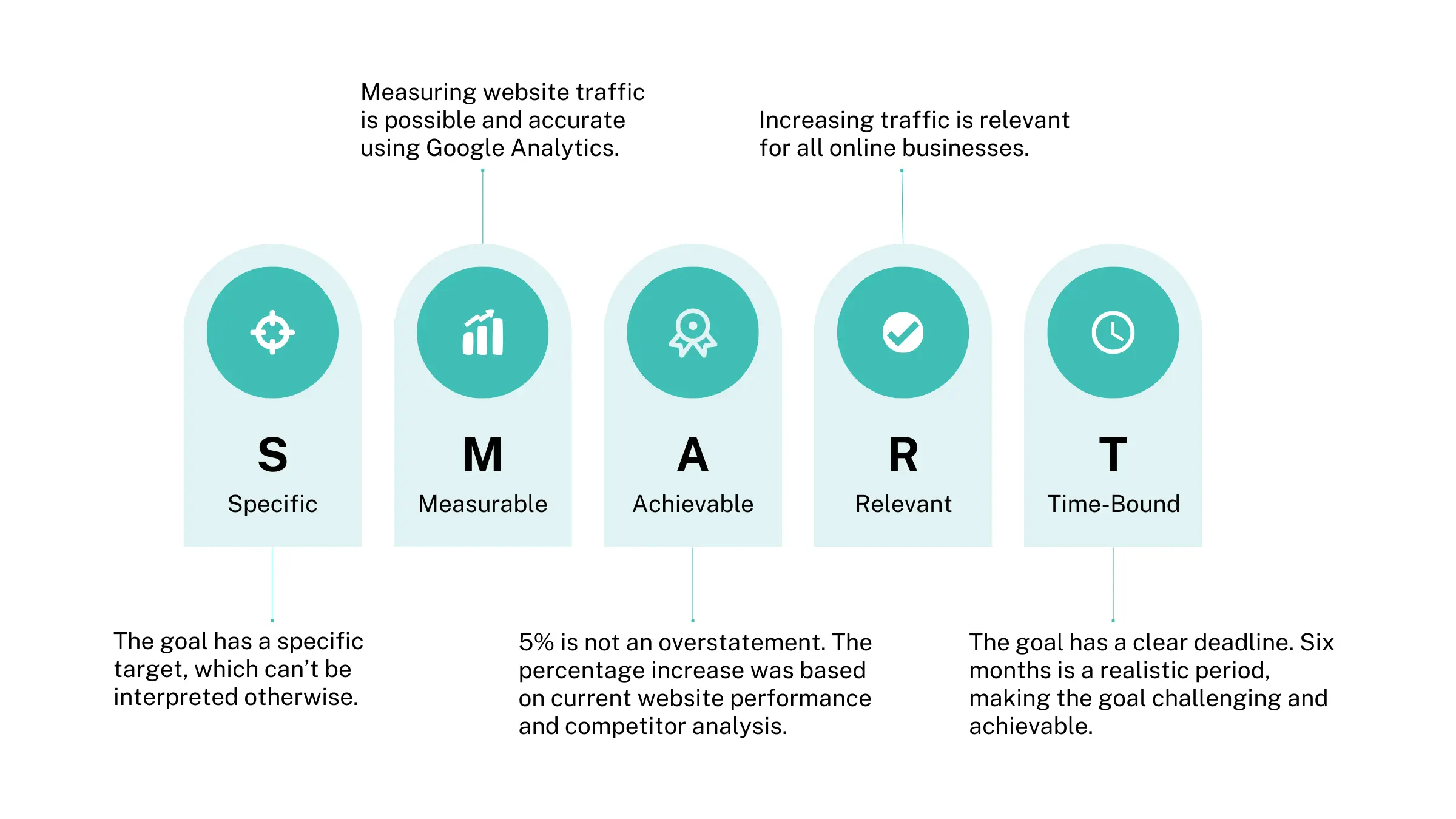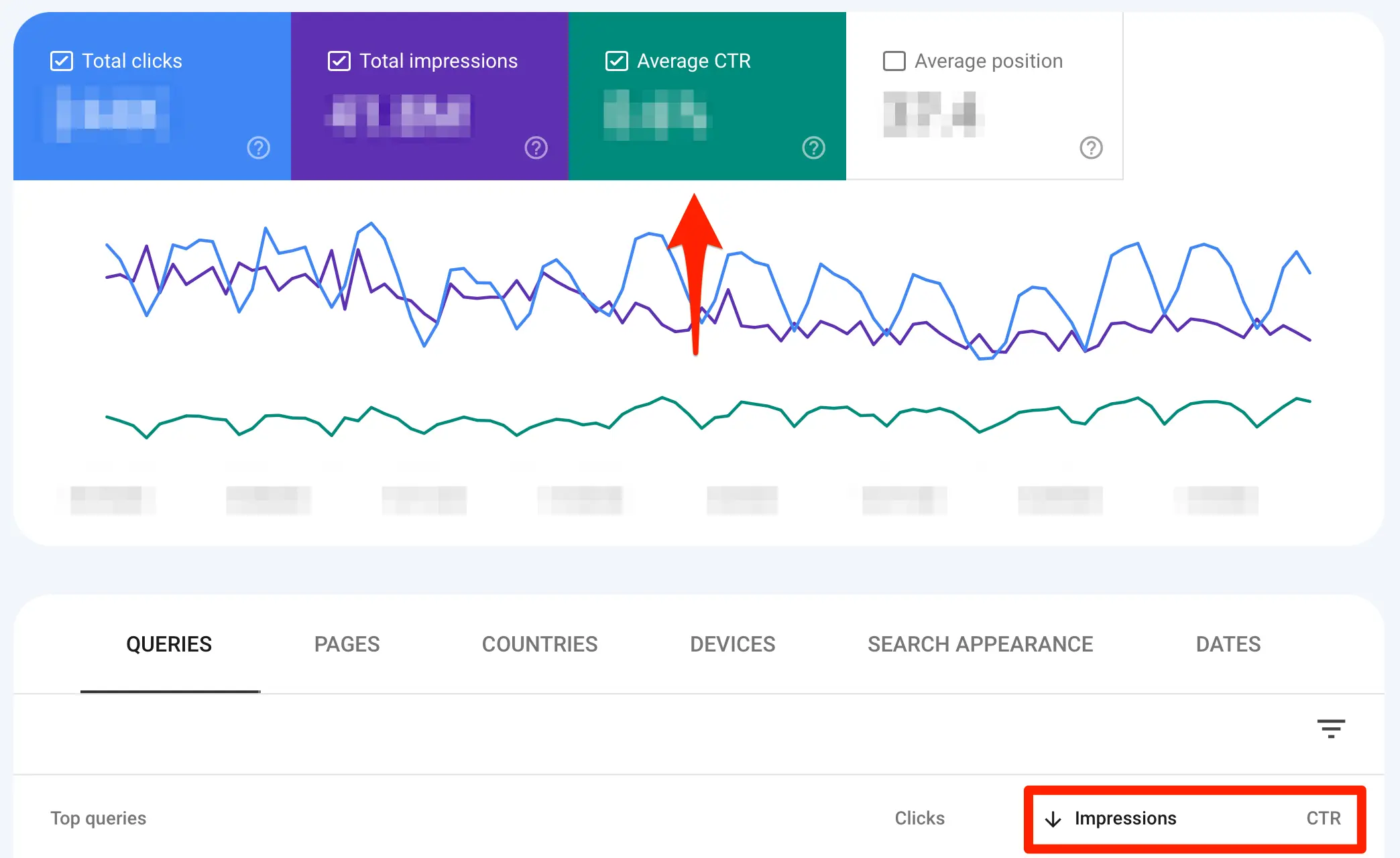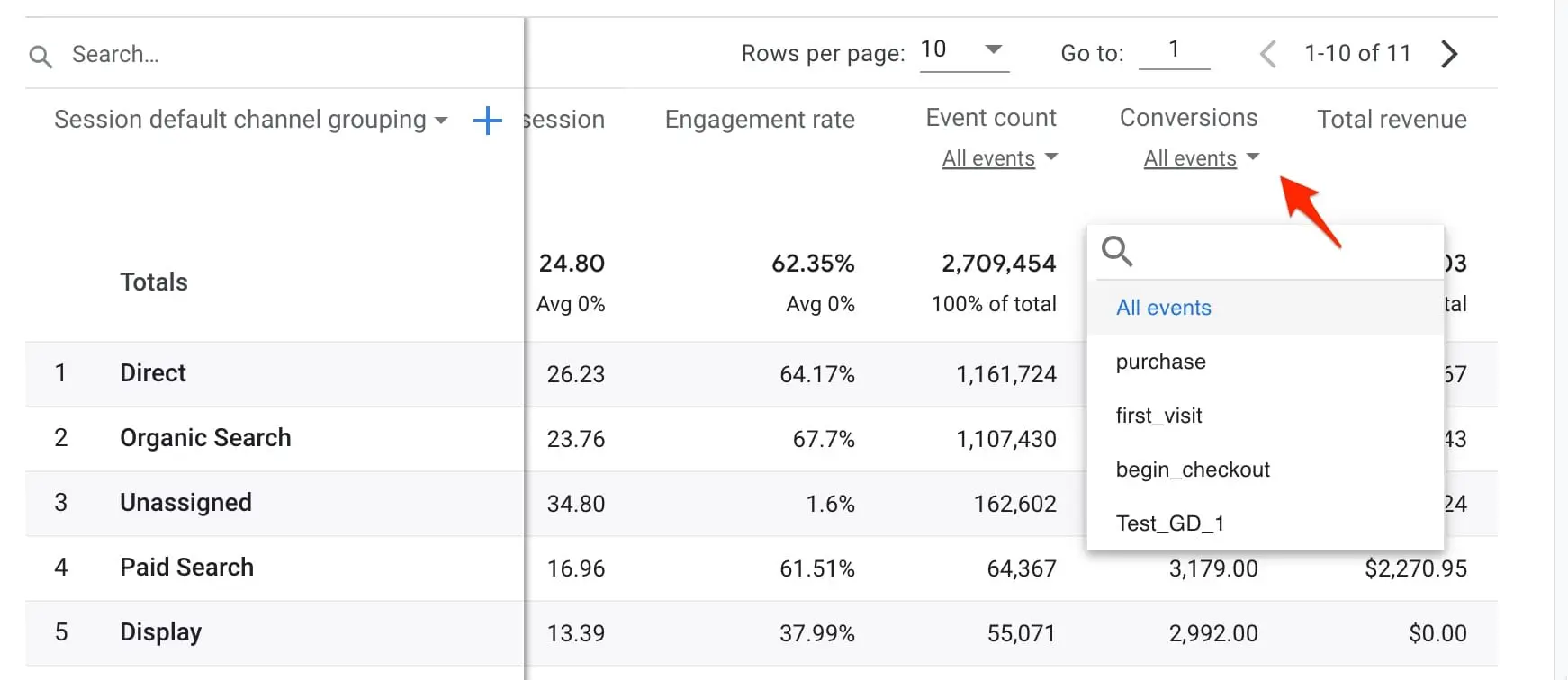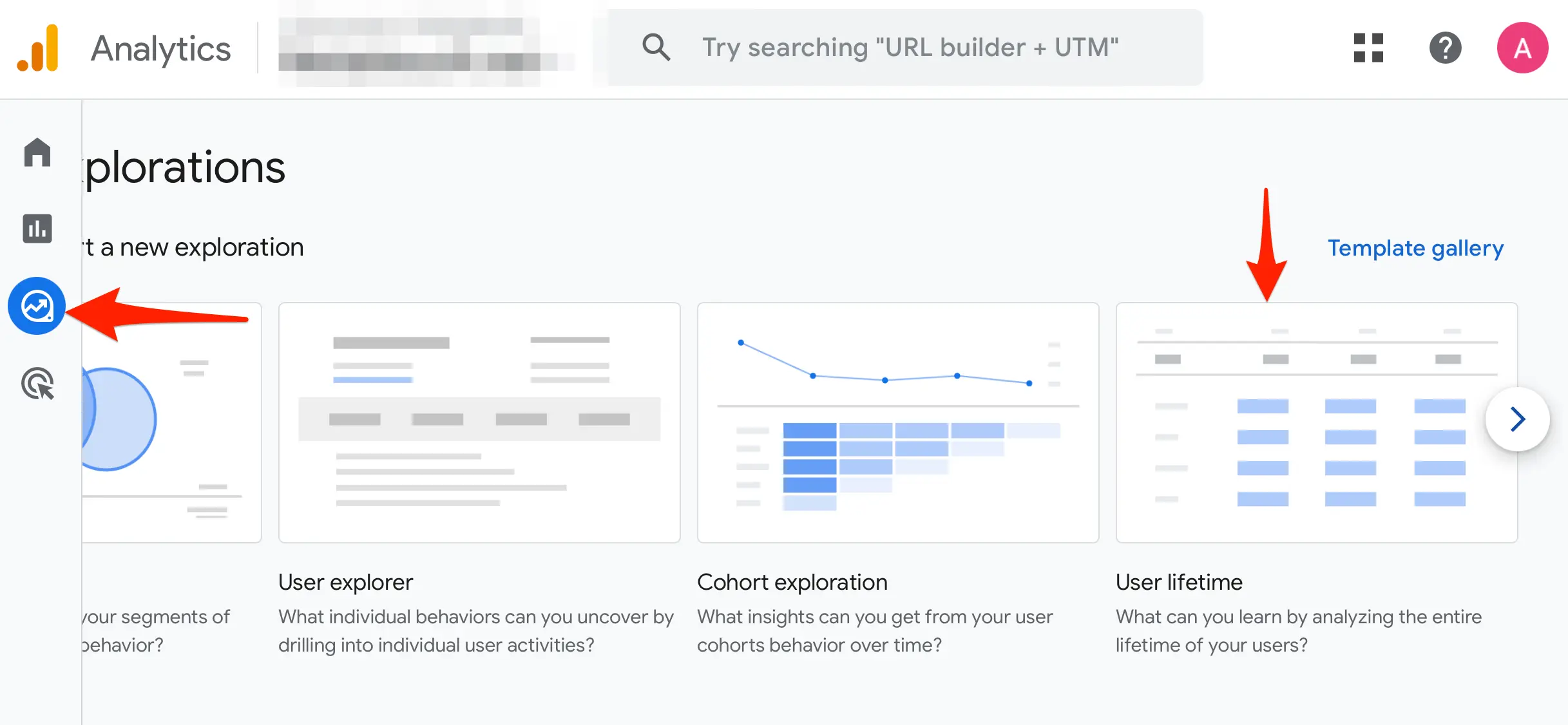What Are Digital Marketing Goals And Why Are They Important?
Digital marketing goals are the metrics (or objectives) you want to achieve from your digital marketing campaigns. Some common goals include increasing website traffic, generating more leads, and raising brand awareness.
Digital marketing goals are important because they help you determine the success of your marketing efforts. Having goals makes it easier to measure progress and adjust your digital marketing strategy to get the best possible results.
How To Set SMART Digital Marketing Goals
When setting your digital marketing goals, you should follow the SMART approach. Any goals you set for your business should be Specific, Measurable, Achievable, Relevant, and Time-Bound.
Here is an example of a SMART GOAL: Increase your website's organic traffic by 5% in 6 months.

Let's analyze this goal to see how different it is from a general goal like "Increase website traffic".
- Specific - The goal has a specific target, which can't be interpreted otherwise.
- Measurable - Measuring website traffic is possible and accurate using Google Analytics.
- Achievable - 5% is not an overstatement. The percentage increase was based on current website performance and competitor analysis.
- Relevant - increasing traffic is relevant for all online businesses.
- Time-Bound - The goal has a clear deadline. Six months is a realistic period, making the goal challenging and achievable.
To implement this goal, you can use different marketing techniques, such as SEO and content marketing. Monitoring your results regularly will help you refine your strategy and achieve the 5% increase in the defined six-month period.
Besides setting SMART goals, monitoring the right metrics and aligning your marketing goals with business objectives are equally important. Let's look at the most popular marketing goals you can set for almost any kind of business.
7 Digital Marketing Goals to Help You Grow Your Business
- Increase Website Traffic
- Improve Organic Rankings
- Build Brand Awareness
- Generate More Leads And Sales
- Establish Brand Authority
- Improve Customer Engagement
- Increase Customer Lifetime Value (CLV)
1. Increase Website Traffic
Increasing website traffic is the number one goal for most online businesses. The reason is simple: more traffic can lead to more conversions and sales, helping a business achieve its financial goals.
It's worth noting that if you don't make this goal specific, you may focus on activities that will not help your business. As a digital marketing service provider, we see businesses repeatedly make this mistake.
When it comes to traffic, your goal should be to get more targeted traffic that will generate more sales and revenue. Traffic coming from search engines or Search Ads is a great source of targeted traffic.
Here are a couple of examples of specific website traffic goals:
- Increase organic traffic by 5% in the next 6 months (the example demonstrated above).
- Increase traffic from Google Search Ads by 10% by the end of the year.
How do you determine your specific target percentage?
You need to look at your analytics platforms (Google Analytics, Google Search Console, Google Ads Reporting, etc.) and evaluate your website's current (and past) performance in particular metrics. Then, based on that, you can set challenging and realistic goals.
For example, if your organic traffic increased by 5% in the last 12 months (compared to the previous period), you can set a goal of achieving an 8% increase in the next 12 months.
2. Improve Organic Rankings
Most businesses rely on search engine traffic to survive. If that's the case with your business, improving your organic rankings should be at the top of your goal list.
To make this goal meaningful, it has to specify for which keywords you want to achieve a better ranking.
Log in to your Google Search Console and view the Performance on Search Results report. Click on the Average CTR tab and look for search queries with high impressions but low CTR.

These queries are good candidates to include in your digital marketing goals because they already get impressions (which means they are showing somewhere in the search results) but not many clicks. Improving their ranking position will drive more clicks and traffic to your site.
Here is an example of a goal you can set: "Improve the ranking position of [keyword] to reach the top positions of Google".
In practice, you can achieve this by following SEO best practices, such as updating your content, optimizing for featured snippets, and building links to the specific page.
3. Build Brand Awareness
The more people are aware of your brand, the greater your chances of performing better in Search and getting better results for your PPC campaigns. It is said (the rule of Seven) that a person needs to interact with a brand's message at least 7 times before they convert.
The problem with brand awareness as a goal is that it is difficult to measure. Unlike organic rankings, traffic, and conversions, there is no single metric to use for brand awareness.
What you can do instead is to set a combination of goals. Here are a few examples:
- Get 300 new Facebook followers with Facebook Ads.
- Increase email subscribers by creating a free ebook to encourage sign-ups. Notice that a specific number is missing from this goal. If you have run similar campaigns in the past, you can set an attainable number based on experience.
4. Generate More Leads And Sales
All companies' most important digital marketing goal is increasing leads and sales. A lead is any conversion (newsletter signup, submitting a contact form, scheduling a demo, signing up for a free trial) that can get users to the bottom of a sales funnel so that they will eventually proceed to a purchase.
The conversion rate metric is the best way to set this as a marketing goal. The conversion rate is the number of visitors who made a purchase (multiplied by 100 to convert the number into a percentage).
Login to your Google Analytics account and review the conversions report for the last few months. Divide that number by the total visits (you can get that in the Traffic Acquisition report) and multiply by 100. This is your conversion rate for the specified period.

In your digital marketing plan, set a goal to increase your conversion rate by a number that is slightly above your current rate.
You can do that by following conversion optimization techniques and optimizing your landing pages.
5. Establish Brand Authority
One of the objectives of digital marketing is to build an authoritative brand. This is different than building brand awareness (goal 3). Establishing brand authority means positioning your brand as an authority in your industry. It involves not just being known but also being known for offering reliable advice and solutions your audience can trust.
To set this as a digital marketing goal, focus on creating and sharing high-quality, informative content that addresses the needs and questions of your audience.
Here are a few examples:
- Deliver webinars - discussing problems and solutions trending in your industry.
- Industry case studies - creating and publishing original reports and research.
- Take initiatives - follow the examples of global brands and create campaigns that touch on social issues.
6. Improve Customer Engagement
The more you can keep visitors on your site, the better your SEO and conversions will be. Users who return to the search results and continue searching for the same topics after visiting your website send negative signals to Google, which impacts your ability to rank in the top positions for your target keywords.
Two metrics that measure engagement are the engagement rate and the bounce rate. The first thing to do is go to Google Analytics and add these metrics to your reports.
Go to Pages and Screens” report under Life Cycle / Engagement. Click the ‘Customize Report’ button (top right corner) and then click METRICS.
Select Engagement Rate and Bounce Rate and add them to your reports.

Next, set specific goals to reduce the bounce rate and increase the engagement rate for particular pages.
7. Increase Customer Lifetime Value (CLV)
Customer lifetime value is the total money a customer can spend with your company. If you're selling only one product, the CLV is the value of that, but if you're selling multiple products and services, the CLV value can vary.
CLV should be part of your marketing goals for two reasons. First, the cost of acquiring new customers is 10X the cost of maintaining a customer, and second, existing customers can become the best representatives of your brand, boosting awareness and credibility of your business.
If you don't have a system to calculate the CLV, you can get it from Google Analytics.
- Sign in to Google Analytics.
- On the left, click Explore.
- At the top of the screen, click Template Gallery, then select the User lifetime template.
This report will show the Average Lifetime Value (LTV) per channel, which is super helpful for setting goals.

The most common techniques for improving customer lifetime value are:
- Providing excellent customer service.
- Running retargeting campaigns on Facebook and Google.
- Winning the social proof game with positive reviews and testimonials from customers.
- Creating new products/offers for existing customers
How to Align Digital Marketing Goals with Business Objectives
Setting goals is useless if these are not aligned with business objectives. At the end of the day, digital marketing should help a business fulfill its financial goals. For example, even if you manage to increase website traffic by 10%, if this goal is not bound to a business objective, it won't contribute to business growth.
Let's see how to match digital marketing goals with business objectives.
1. Understand Your Business Objectives
The first step is identifying what it will take to grow your business. Some typical objectives are increasing profits, growing your customer base, expanding into new markets, improving your existing products, or launching new products and services.
Once you have this defined, you can map it to digital marketing goals.
For example, if your business objective is to increase revenue by 10% in the next year, your marketing goal could be to increase the conversion rate from 2% to 4%. The increase in sales will result in more revenue.
You may have to define one or more marketing goals to meet a business objective. For example, to increase the conversion rate, you'll need more traffic, and to get more traffic, you'll need to increase your SEO efforts.
By breaking down business objectives into meaningful marketing goals, you can create an action plan to monitor and adjust based on results.
2. Choose Relevant SMART Goals
We've already discussed this above, but it's worth mentioning again that any marketing goal you set has to be SMART (Specific, Measurable, Achievable, Relevant, Time-bound). This means choosing actionable targets that directly support your business objectives.
For example, if your business objective is to expand your customer base, a relevant SMART goal could be to increase new customer sign-ups by 15% in the next six months through targeted Facebook ads campaigns.
For this goal to be effective, your past performance with Facebook Ads should be close to 15%. If you don't have a benchmark, you set an initial target, monitor it closely monthly, and adjust it based on actual data. Setting a goal that is too optimistic and thus not achievable does not serve any purpose.
3. Communicate Goals With All Departments
Setting goals is not the sole responsibility of the digital marketing team; everyone in the company should work towards the same objectives. The marketing team will set the path, and all departments should contribute to achieving them.
Here is an example from one of our clients that will help you understand this better. One of the goals of a jewelry company was to become an authority in the engagement ring niche, and part of the content marketing goals was to publish blog posts explaining the different types of ring setups.
Instead of hiring writers to create content, this task was assigned to the company's stone experts. The result was awesome content, different from the AI content that circulates the web, that helped the website gain organic traffic and links.
4. Monitor Goals And Adjust Your Strategy
Accurately measuring and tracking progress is critical to the success of any digital marketing campaign. For example, to measure your conversion rate, you need to have analytics properly set up and enable conversion tracking on Facebook and Google Ads.
The first action is to review your environment and ensure that all important actions are recorded. Use a reporting tool like Google Looker Studio to gather relevant data into unified dashboards. This is, by far, the best way to monitor your campaigns' performance.
The second action is to create milestones bounded to specific dates. For example, if you have set a goal to increase traffic by 30% in six months and your traffic changed by only 2% after three months, you need to revise your goal or strategies.
Most of the time, your strategy will be based on assumptions, and the only way to check if your assumptions are correct is to review and adjust your strategy based on actual data regularly.



